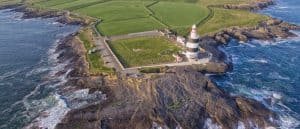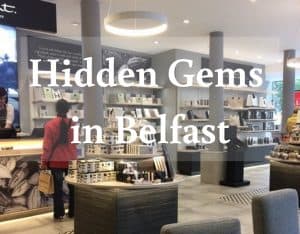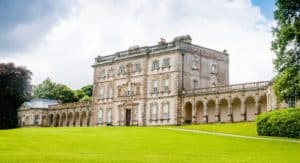The Influence of Norse Mythology on Irish Folklore: Captivating Culture and Tales

Updated On: April 24, 2024 by Fatma Mohamed
The rich tapestry of Irish folklore brims with tales that are intricately woven with threads from Norse mythology, mirroring a past where these two cultures intersected. Our understanding of the impact that Norse legends have had on Irish narratives can be seen in the shared motifs and mythological figures that appear in stories from both traditions. This blend showcases a cultural exchange rooted in the historical Viking presence in Ireland, which left a lasting imprint on the country’s oral tradition and collective consciousness.
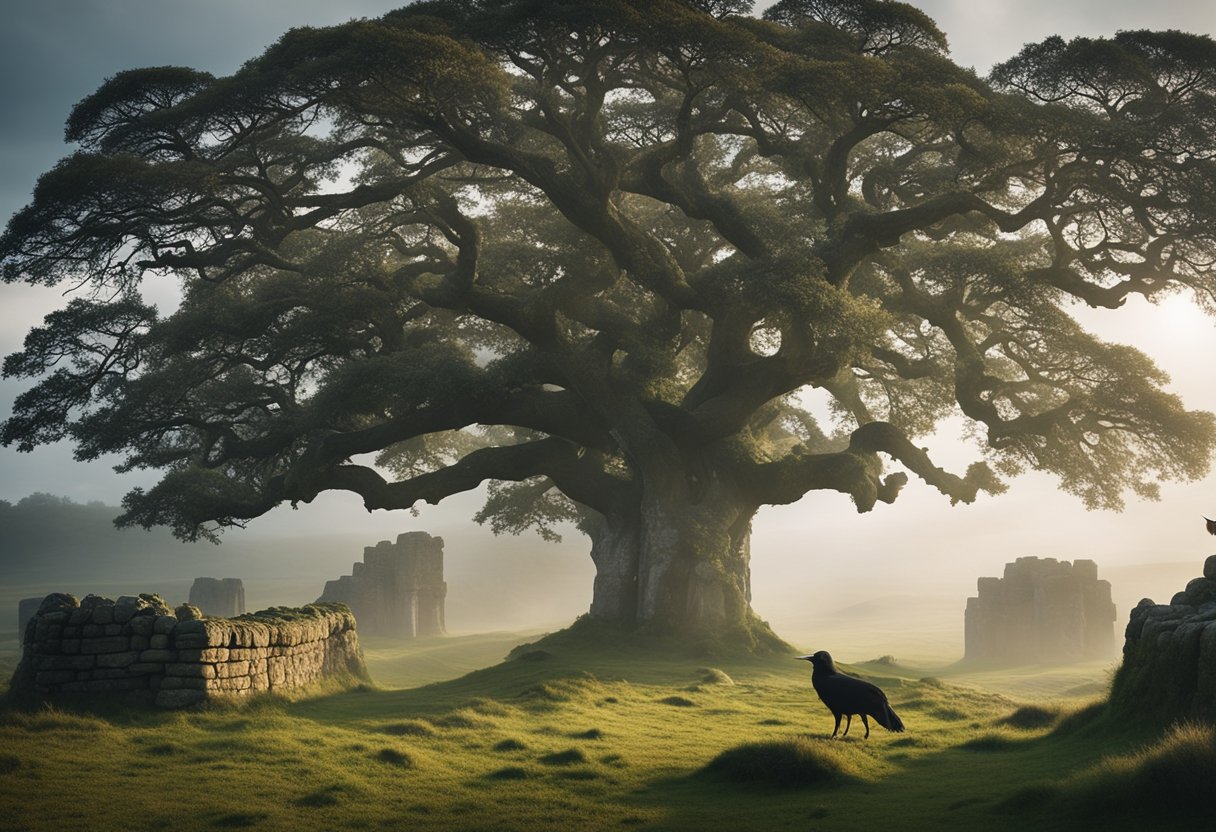
Norse influence is evident not only in the mythological themes but also in the everyday language and place names scattered across Ireland. The Irish folklore that we cherish today has been shaped by centuries of storytelling, evolving to include elements of Norse myth that add a layer of complexity and depth to the existing Celtic folklore. By examining the points of convergence between the narratives of the Norse and the Irish, we gain insights into how mythology functions as a bridge between cultures, preserving a shared heritage that continues to captivate our imagination.
Table of Contents
Historical Context of Norse and Irish Interactions
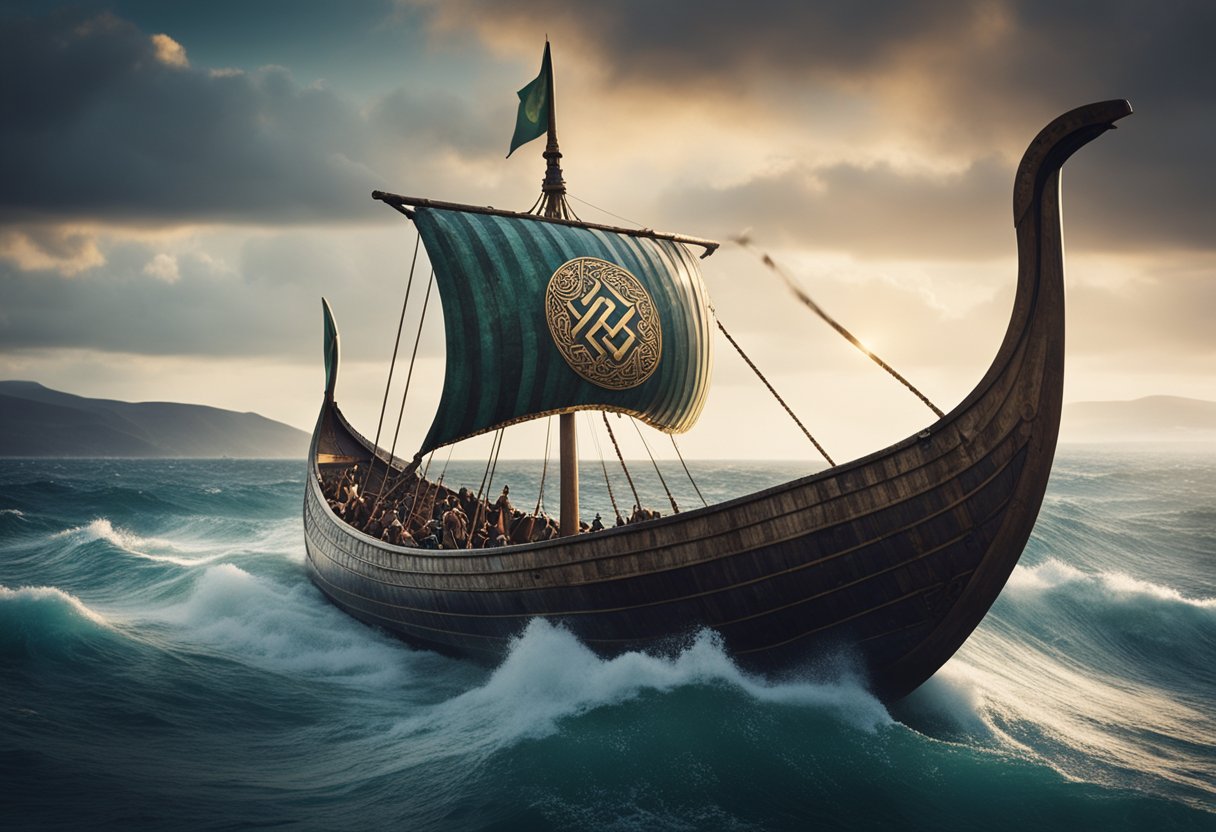
In the Middle Ages, the Vikings, seafaring warriors from Scandinavia, began to interact with the Celtic inhabitants of Ireland. Our saga commences around the end of the 8th century, with the Norsemen initiating raids and eventually establishing settlements on the Emerald Isle. Their arrival injected a new dynamic into the existing Irish society, which was deeply enmeshed in its own Celtic and Christian traditions.
Viking Raids and Settlements:
The Norse incursions were marked by the plundering of monasteries and towns, but over time, these raids gave way to more stable occupations. The Vikings founded important Irish cities such as Dublin and Limerick, initially as trading hubs and military fortifications.
- Cultural Interweaving:
The Norse influence permeated Irish life, as seen in the introduction of new words and craftsmanship styles. The two rich mythologies, Norse and Celtic, began to intertwine, with Irish mythology absorbing facets of Norse legends.
Resistance and Integration:
Despite initial resistance to the Viking presence, over time, there was increasing intermarriage and integration of the Norse settlers into Irish society. This blending is carried over into stories and legends, with Norse gods and Irish mythic figures sometimes appearing side by side in folk tales.
Christian Influence:
The Norse settlers, originally pagans, gradually converted to Christianity, which further facilitated their integration into Irish life. This conversion also meant that Norse mythology began to be influenced by Christian ideas, just as the settlers were influencing Irish tales.
Our understanding of this period is enhanced by sources such as the 11th-century monks who chronicled the legends of the Tuatha Dé Danann alongside the insights gleaned from Norse sagas. These sources help us piece together the complex tapestry of Norse and Irish interactions during the Middle Ages.
Mythological Symbiosis
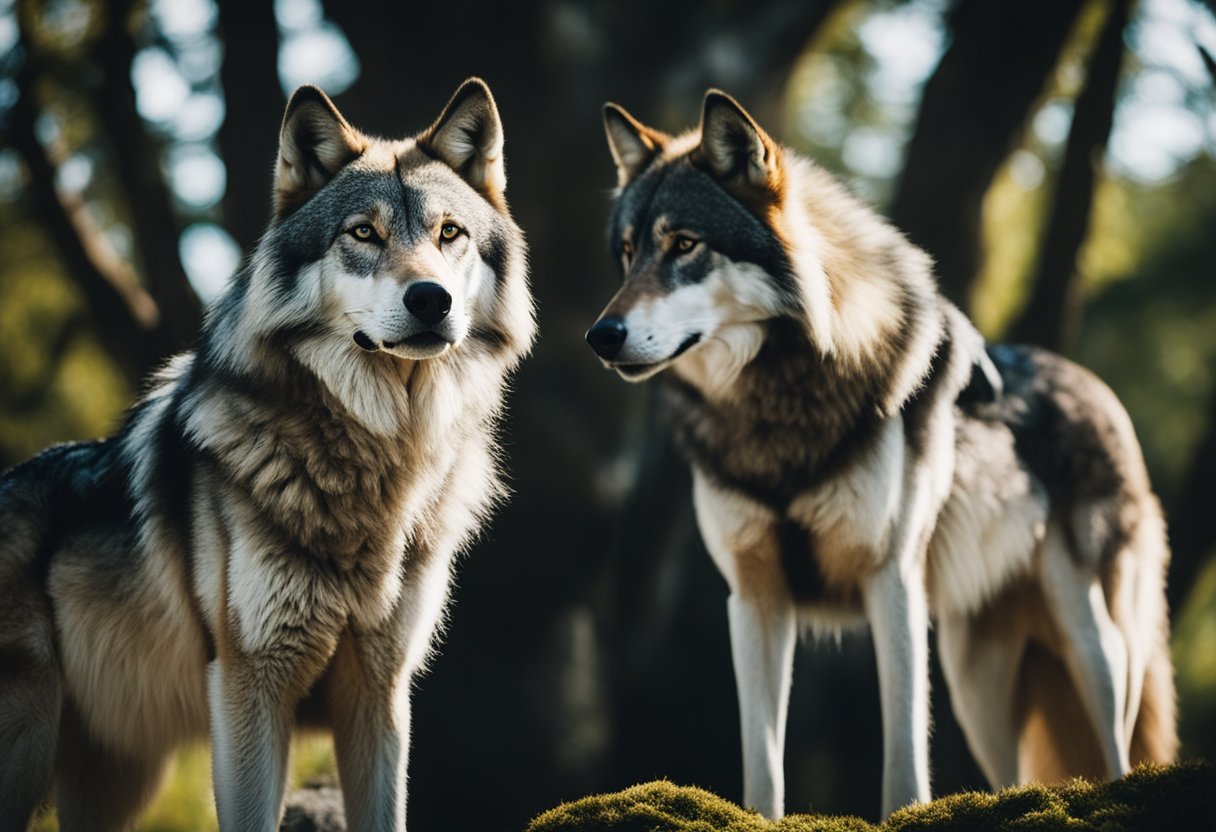
In our exploration, we’ve observed how the Norse and Irish mythologies have intricately woven together, forming a rich tapestry that reflects the blending of cultures during the Viking Age.
Integration of Norse Deities
Within Irish folklore, the presence of Norse gods can be noticed through the incorporation of certain deities into local myths and legends. For instance, the Norse god Loki has often been compared to the Irish deity Lugh, both of whom embody trickery and skill. The Norse influence is also seen in the way certain Celtic gods were depicted with attributes commonly associated with their Norse counterparts, hinting at a cultural exchange that softened the boundaries between the two pantheons.
Comparative Myth Structures
Comparing the structures of Norse and Celtic mythologies reveals strong narrative parallels. Notably, both traditions feature a cosmological world tree—Yggdrasil in Norse belief and Bíle in Celtic lore—which signifies the interconnected nature of all life. Additionally, Irish legends often echo the Norse concept of interconnected realms, with tales of the Otherworld that have distinct similarities to the nine worlds of Norse cosmology. Furthermore, the impact of Christian influence can be identified in both mythologies, as seen in the way pagan gods were transformed into heroes or historical figures within the legends over time, typifying the synergy between the ancient and the encroaching Christian beliefs.
Cultural Exchange and Syncretism
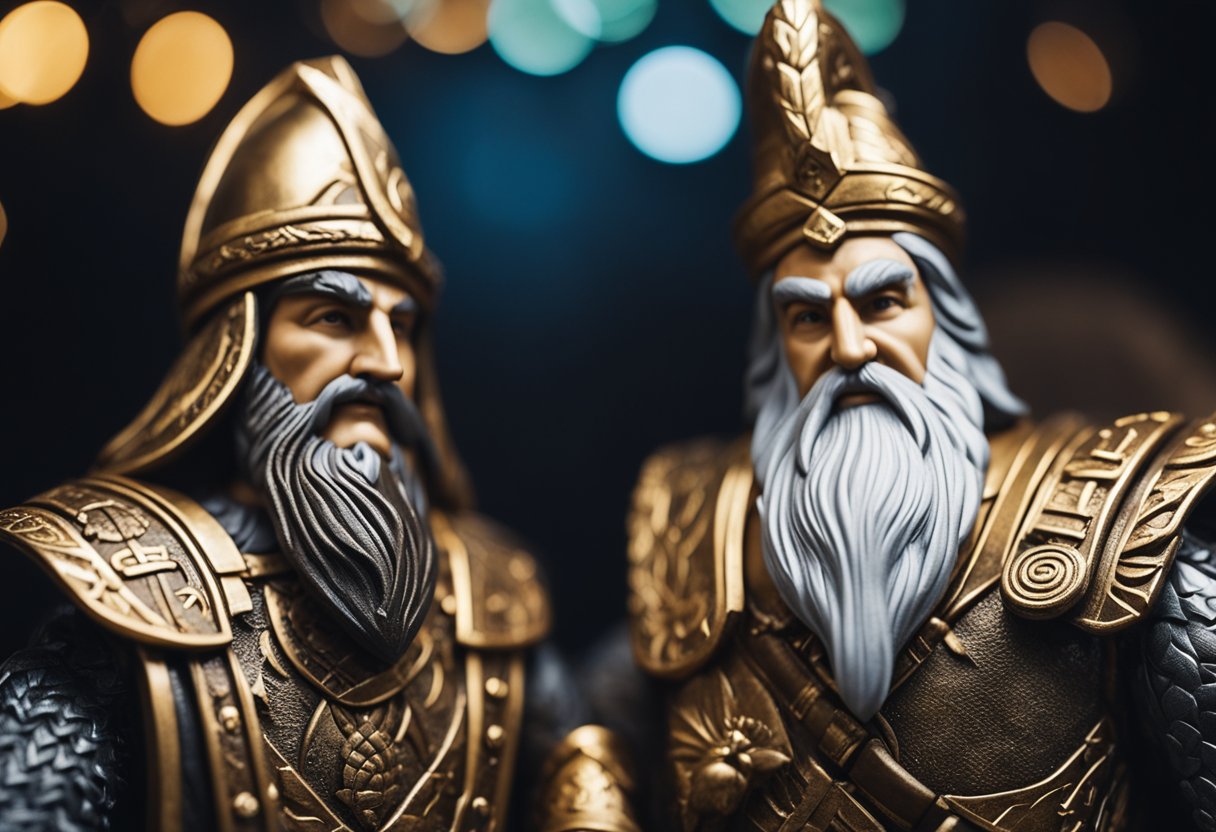
In this discussion, we consider the intricate ways in which Norse mythology leaves its indelible mark on Irish folklore, shaping it through the complex processes of cultural exchange and syncretism.
Language and Literature
Norse mythology has deeply influenced the fabric of Irish literature, particularly through the intermingling of language and storytelling methods. The Norse sagas, once disseminated by oral tradition, found a new life in Ireland as Christian monks began to transcribe these stories. These writings often preserved elements of Norse vernacular, embedding foreign expressions within the local manuscripts. Old Norse words were grafted into the Irish lexicon, leaving a lasting legacy that extends beyond tales of valour and into everyday speech.
Art and Iconography
The tendrils of Norse influence extended into Irish art, permeating its iconography and styles. We can trace a visual synergy in media, such as the high crosses in Ireland, where some motifs bear a striking resemblance to Norse ornamentation. This confluence is a testament to the exchange between Viking carvers and Irish artists of the time. Viking artistic practices, particularly those concerning metalwork and stone, were often adopted and adapted by Irish craftsmen, creating a distinctive hybrid style. This style bears witness to the Norse saga intricately woven into Ireland’s cultural tapestry.
Key Figures and Heroes
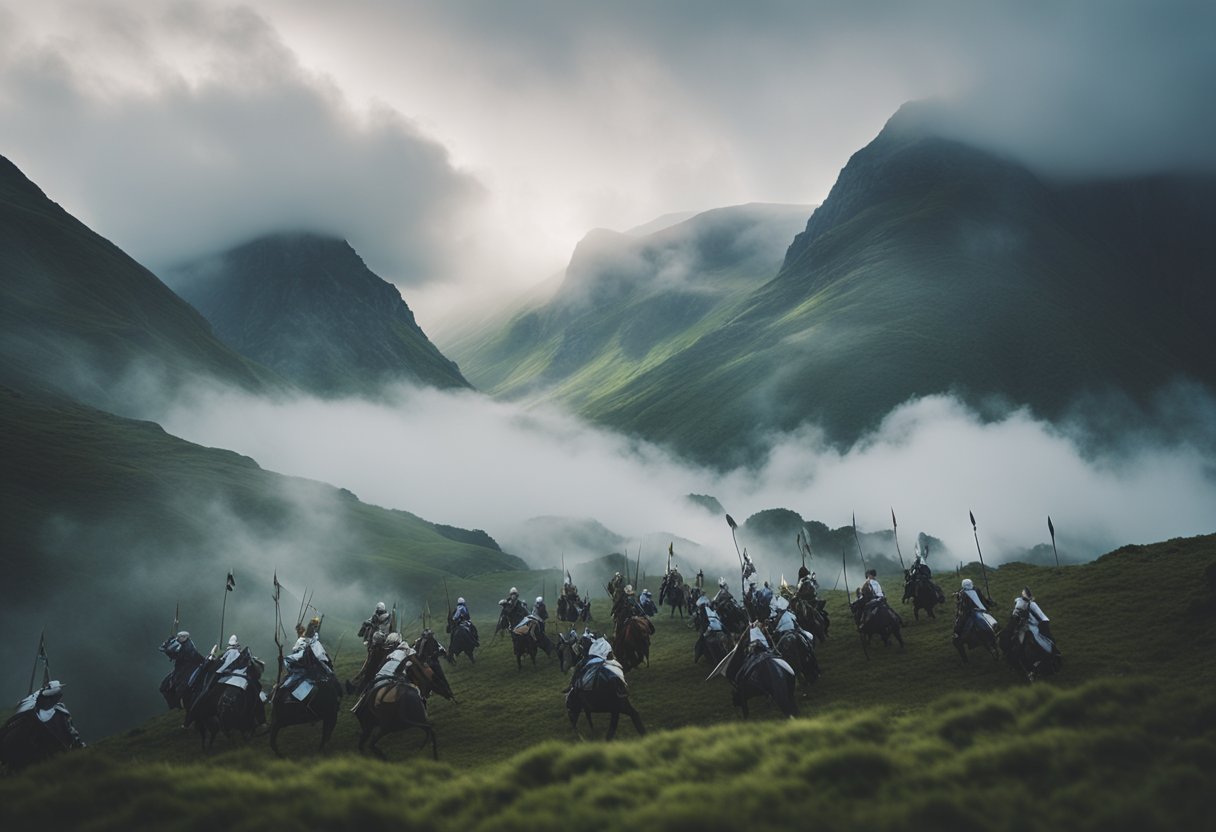
In the tapestry of Irish folklore, certain figures stand out for their deeds and legacies. These individuals embody the values and cultural narratives that have been passed down through the generations, shaping Ireland’s mythological landscape.
Fionn Mac Cumhaill
Fionn Mac Cumhaill, also known as Finn McCool, is a central figure in the Fenian Cycle, one of the cornerstone narratives in Irish folklore. As a mythic hero, he’s renowned for his wisdom, leadership, and warrior skills. Leader of the Fianna, a band of warriors, Fionn is best known for his role in the legend of the Salmon of Knowledge, which granted him all the world’s wisdom.
Other Notable Legends and Heroes:
- Cú Chulainn: Often likened to Achilles, Cú Chulainn is famed for his superhuman abilities and is a key character in the Ulster Cycle. His story is one of tragedy and valour.
- King Lir: His tale, which revolves around the tragic transformation of his children into swans, reflects themes of love, loss, and endurance.
- Brian Boru: A historical figure who became a legendary king, renowned for his role in the battle of Clontarf in 1014, which diminished Viking power in Ireland.
We find that these heroes and kings are not just bound by Irish shores but have parallels with Nordic sagas, suggesting a shared heritage of valour and strength in the mythologies across the Northern seas.
The Natural and Supernatural
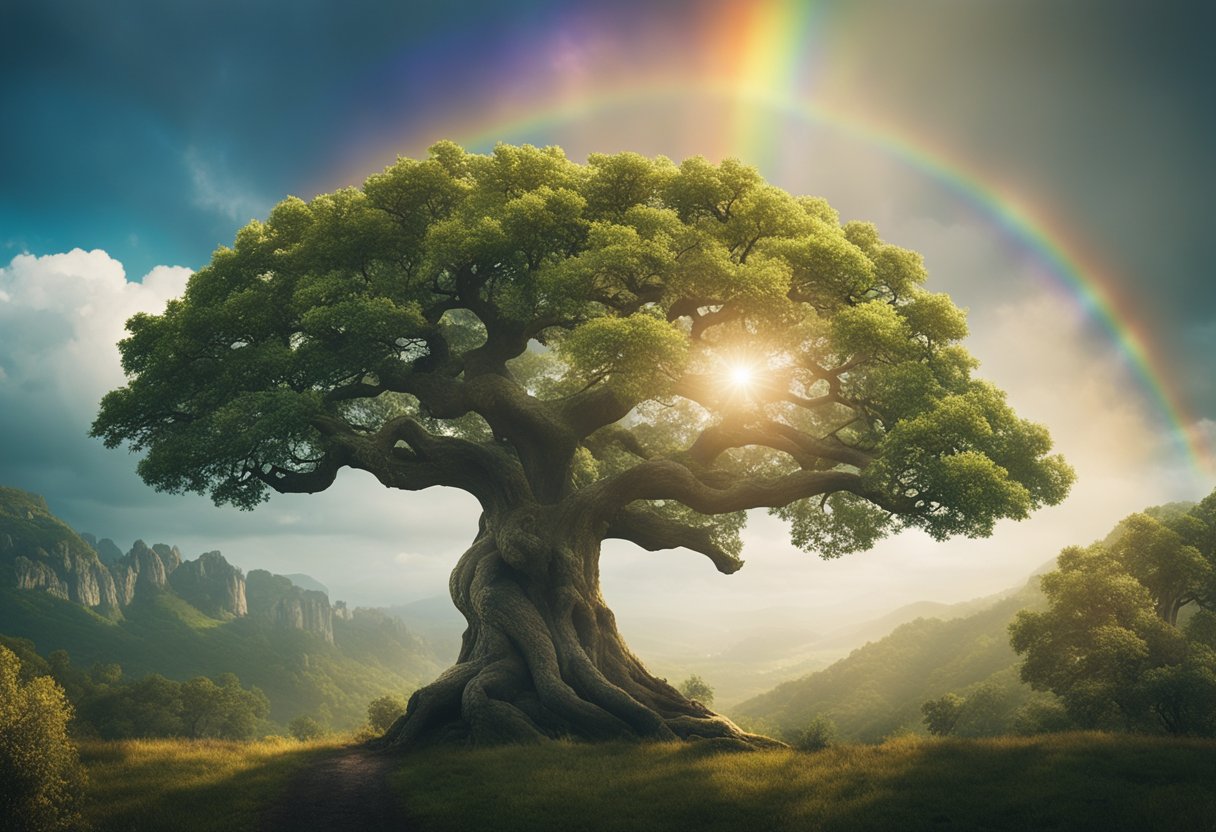
In our exploration of the intertwining of Norse mythology with Irish folklore, we encounter a complex tapestry where the natural world and an array of supernatural beings coexist. Within this framework, elements of both Norse and Irish traditions merged, shaping a unique cultural narrative that still piques our curiosity today.
Otherworldly Entities
The Otherworld is a prominent concept in Irish folklore, often considered a parallel realm where fairies and deities reside. Norse mythology also speaks of other realms, like Ásgard, where the Norse gods live. The Irish tales of fairies (often referred to as the “Aos Sí”) share similarities with Norse elves, with both cultures envisioning these entities as powerful forces tied to nature and capable of influencing human lives. Changelings, another supernatural feature of these traditions, are believed to be fairy offspring swapped with human children.
Reflecting on the mythology of both cultures, we find deities that oversee elements of life and nature. Norse gods like Freyr and the Irish goddess Áine exemplify divinities associated with fertility and agriculture. Their narratives often overlap with stories of mythical creatures; for example, the Irish Púca shares kinship with shapeshifting entities found in Norse lore.
Nature in Myths
In both Irish and Norse mythologies, nature holds a sacred and vital place. The Irish reverence for natural sites such as hills, wells, and trees mirrors the Norse veneration for forests and bodies of water, both seeing them as dwelling places or spiritual portals for supernatural beings.
The supernatural beings in these mythologies are inseparable from the natural environment, embodying its forces and rendering it enchanted. It is in this enchantment where we find the most significant influence of Norse mythology on Irish folklore: a blending of belief systems where each natural element, each hill or wave, has a story that speaks of ancient deities and otherworldly creatures that continue to captivate us.
Rituals, Practices, and Folk Traditions
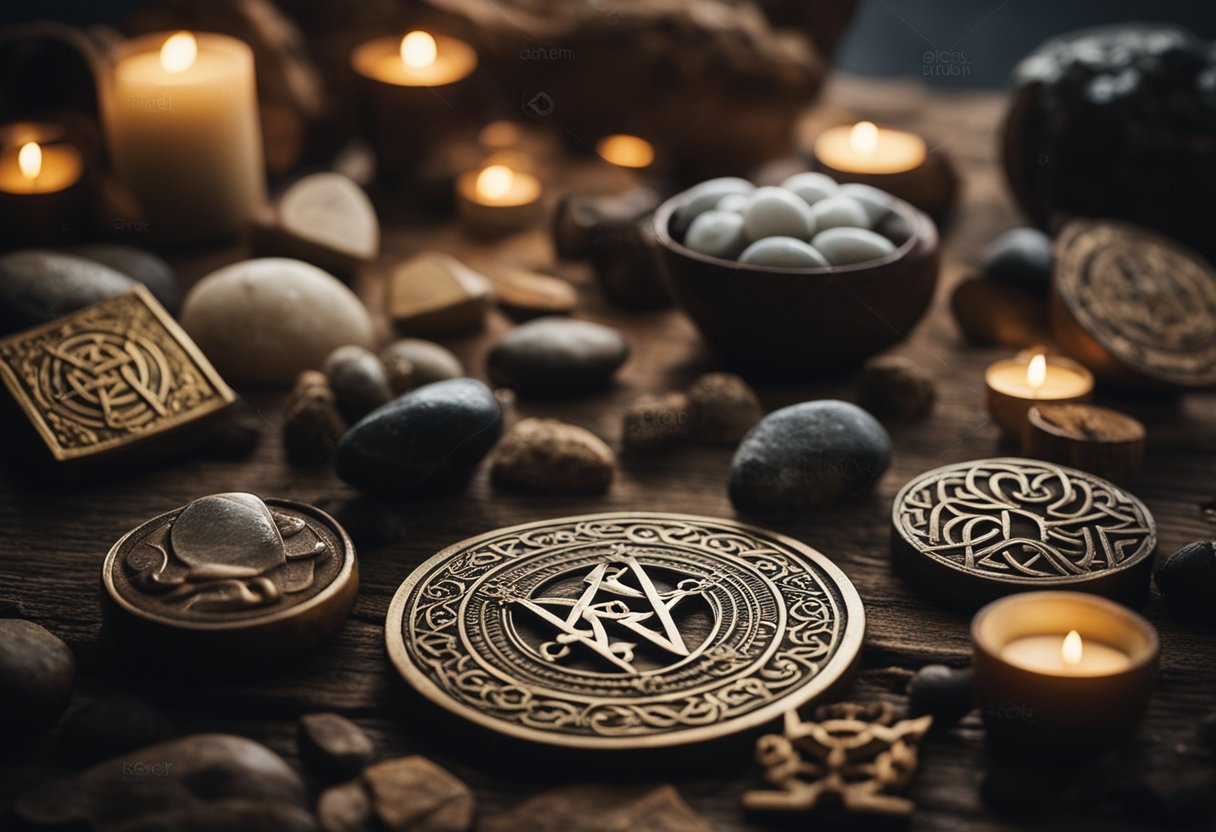
In our exploration of cultural intersections, we recognise the profound impact Norse mythology has had on Irish folklore. Through a mosaic of rituals and folk traditions, remnants of the Norse ethos persist within Irish practices.
The Norse celebrated seasonal transitions with elaborate ceremonies, many of which found echoes in Irish traditions. The spring festival of Ostara, which heralded renewal and rebirth, parallels the Irish Imbolc, presided over by the goddess Brigid. Moreover, the Norse feast of Jól, known today as Yule, shares commonalities with the midwinter customs in Ireland.
St. Patrick, a seminal figure in Irish history, is also associated with the blending of traditions. A practice once rooted in the pagan fires of Beltane was reinterpreted within a Christian context, illuminating the Christian influence on pagan customs. St. Patrick’s use of the bonfire to celebrate Easter Sunday is one such example of the synthesis between the two worlds.
The conversion tactics of St. Patrick reportedly included the integration of native beliefs into the new Christian framework. The famed account of St. Patrick banishing snakes from Ireland is often interpreted symbolically, representing the ebbing pagan practices.
Our rituals and practices, like the Norse blót and the Irish Samhain, have shown resilience and adaptation. They evolved from their Norse pagan roots to accommodate the advent of Christianity, evolving yet retaining their core intent – to unify communities and mark the passage of time with ceremony and meaning.
Norse mythology has left indelible marks on Irish folklore, from mythic tales to daily customs. While the conquests of the Norse are a distant memory, their mythological tapestry continues to enrich the cultural fabric of Ireland.
Tales of Sea and Land
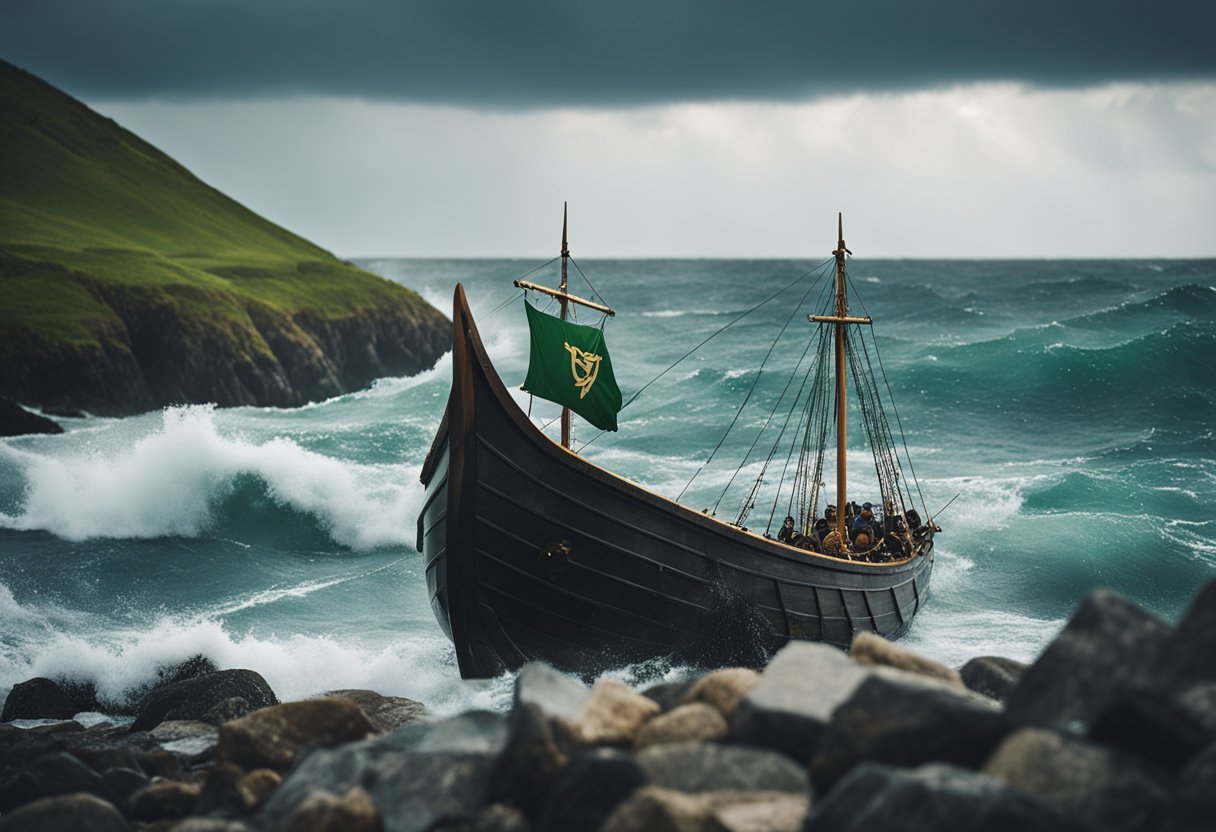
In the rich tapestry of Irish folklore, the imprints of Norse mythology are vivid through tales that intertwine both the sea and the land. These tales are not only stories but also a reflection of Ireland’s cultural heritage that has been shaped by its geographical identity and historical interactions.
Children of Lir
The heartbreaking tale of the Children of Lir stands as a poignant narrative deeply woven into Irish folklore. It tells the story of four siblings who were turned into swans by their jealous stepmother, condemned to spend centuries upon the waves of various seas and lakes until the ringing of a bell from a new church signified their release. This story of transformation and endurance captures the essence of Ireland’s landscape — where the land meets the sea and where tales such as these were likely told around fires to convey lessons and entertain.
Maritime Myths
Ireland’s maritime heritage is rich with myths that speak of the sea’s influence, including fantastic explanations for natural phenomena and stories of creatures that dwell in its depths, like the legendary leprechaun. One enduring maritime myth speaks of Iona, a mystical island associated with various Irish and Scottish tales. Such seafaring legends reflect the deep respect and awe the ancient Irish held for the ocean, an entity that was both a lifeline and a source of mystery. Our history’s pulse can be felt through these stories, echoing the Norse influence on our understanding of the world and the elements within it.
These narratives of mythical lands and fabled creatures continue to be a cornerstone of Irish storytelling, where the convergence of land and sea creates a canvas for the imagination, drawing threads from our Scandinavian neighbours and knitting them into the rich fabric of our folklore.
Influence on Modern Culture and Arts
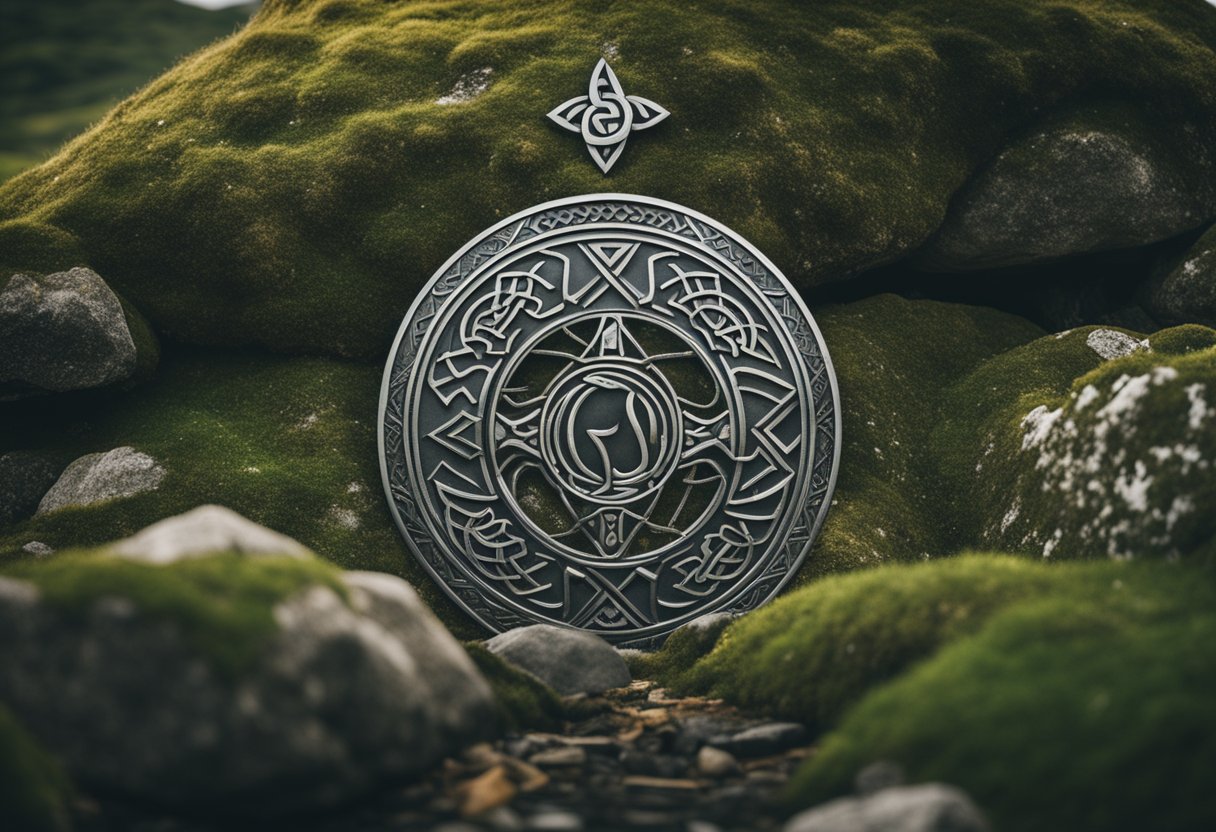
In our exploration of cultural impact, we find that Norse mythology has intertwined with Irish folklore to leave a profound impression on modern culture and arts, particularly through literature and music.
Literature and Poetry
Norse mythology has deeply permeated literature to the extent that its themes are evident in the works of prominent Irish poets like W.B. Yeats. His fascination with supernatural elements and folklore reflects the shared narrative structures and mythological motifs found in Irish and Norse legendary tales. In Yeats’ case, the influence is subtle yet significant, with allusions to mythical figures and concepts that originate from Norse sagas, thereby enriching the textual landscape of Irish literature.
Music and Dance
Moving on to music and dance, Norse mythology’s presence in Irish culture manifests itself not only in the lyrical content of Irish music but also in the thematic inspiration for dance performances. Elements borrowed from Norse lore can be found echoed in the rhythm and intensity of Irish tunes, often telling stories of heroes and battles akin to those from Norse legends. This shared narrative quality has allowed Norse mythology to complement and enhance the traditional arts practised in Ireland, taking root in musical compositions and dance forms celebrated at cultural hubs like the Irish Centre.
Legendary Cycles and Their Preservation
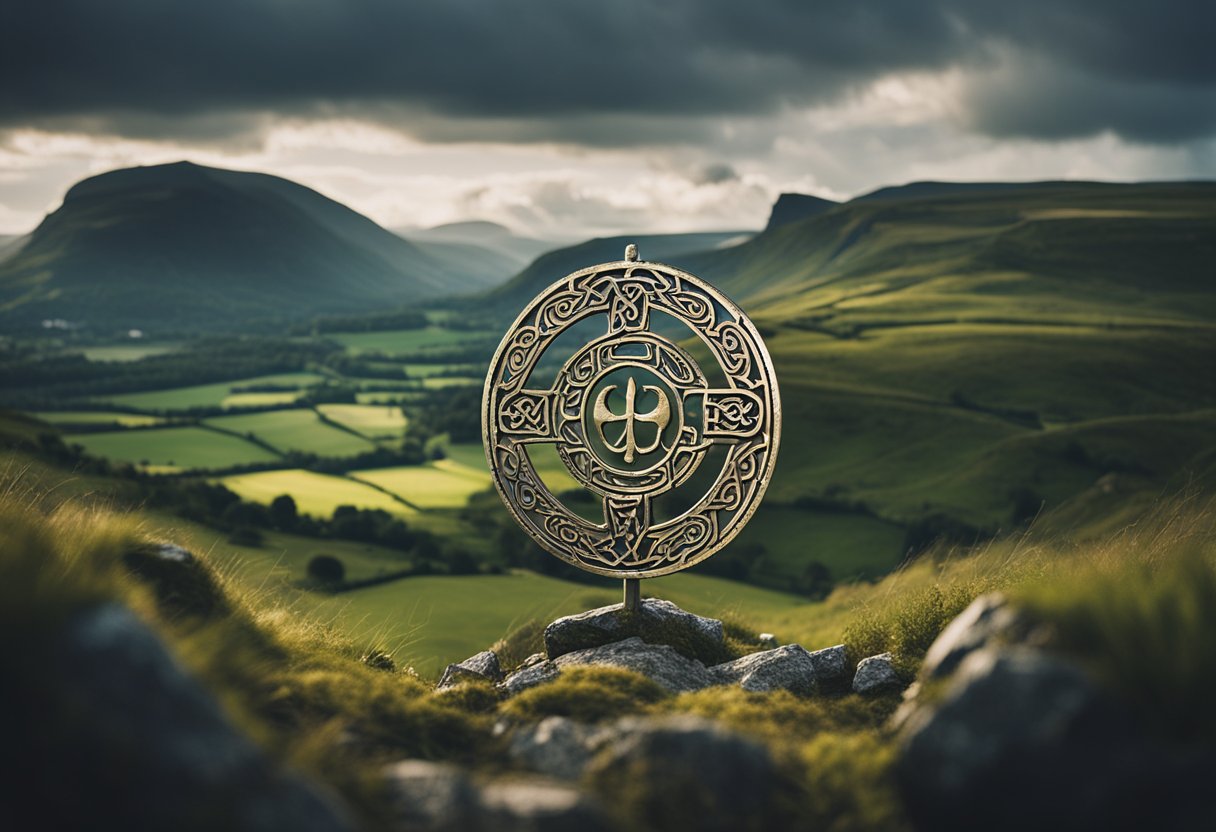
Exploring Irish folklore reveals a tapestry woven from the threads of the Mythological and Ulster cycles, among others. These cycles serve as custodians of culture, chronicling the tales and philosophies of bygone eras.
The Mythological Cycle
The Mythological Cycle captures Ireland’s earliest mythical history, interweaving tales of gods, supernatural events, and the fabled beginnings of the Irish. Central to this cycle is the Lebor Gabála Érenn or the Book of Invasions, a pseudo-historical narrative that traces the lineage and conquests of Ireland’s earliest settlers. The cycle lays the foundation for Irish identity and mythology, highlighting complex narratives that underscore the intersection of myth and recorded history.
The Ulster Cycle
Conversely, the Ulster Cycle is steeped in heroism and brims with the exploits of legendary figures like Cú Chulainn. This cycle includes the renowned Táin Bó Cúailnge (The Cattle Raid of Cooley), an epic that epitomises the valour and turmoil of the period. Regarded for its depictions of chivalry and tragedy, the Ulster Cycle provides a window into the societal values and warrior ethos of early Irish society.
Each of these legendary cycles has been meticulously preserved through manuscripts and oral traditions, securing their place as invaluable assets to our cultural heritage.
Archaeology and Ancestral Heritage
In examining the archaeological records, we uncover the profound influence Norse mythology has had on Irish folklore through enduring structures and ancestral links.
Burial Mounds and Ancient Structures
Burial mounds in Ireland, known as tumuli, offer tangible connections to the Norse settlers who once interacted with the native people. These earthen structures often house significant artefacts that reflect a blend of cultural influences. For instance, objects within the mounds may bear designs indicative of Norse art, echoing the myths and deities that ripple through Irish lore.
Forts such as ringforts stand as testaments to socio-political and ritualistic activities. Their locations and architectural styles indicate a Norse influence on land use, settlement patterns and defensive strategies. As we walk the grounds where ancient peoples once strategised and performed their rites, our understanding of the Norse’s impact on Irish cultural identity deepens.
Additionally, archaeological excavations of settlement sites have unearthed evidence of Norse populations integrating into Irish societies. Tools, domestic structures, and even waste pits at these locations reveal the merging of traditions and daily practices, much as mythologies intertwined over centuries.
Through the meticulous examination of these sites, we gain insight into the Norse and Irish peoples’ shared history, allowing us to appreciate their combined heritage in the landscape of Ireland.
Contemporary Relevance and Legacy
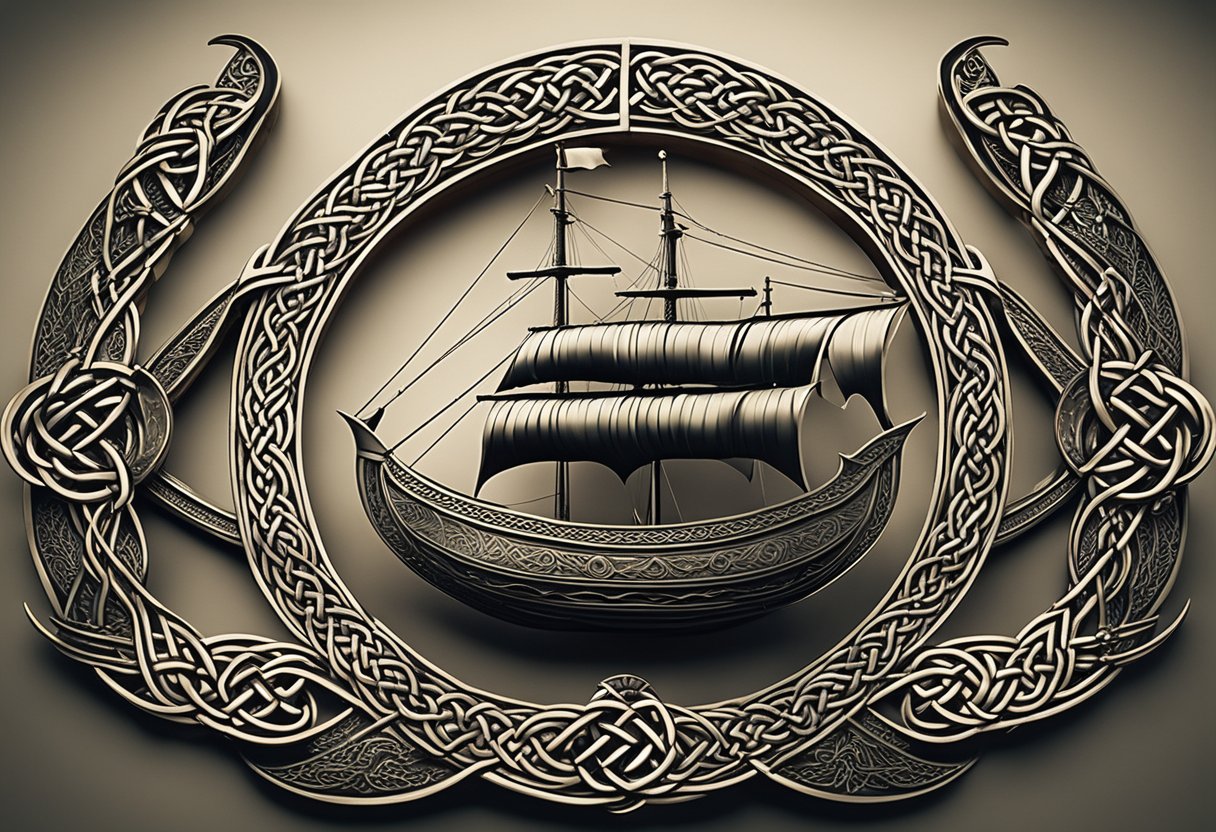
We recognise the profound impact Norse mythology has had on the fabric of Irish folklore. Despite the passage of centuries, these ancient narratives continue to shape modern culture and tradition in Ireland. Norse gods, myths, and symbols have seamlessly intertwined with Gaelic traditions, leaving a legacy that is evident in various facets of contemporary life.
In the realm of media, the fusion of Norse and Irish mythological elements can be seen in literature, film, and television, which often tap into the rich tapestry of these stories, transforming them for new audiences. For example, themes from Norse mythology resonate within Irish storytelling, imbuing it with a distinct character that is both familiar and novel.
Norse mythology has also permeated the language, with several Irish words bearing roots in Norse terms, indicative of the historical confluence of these cultures. This linguistic blend is a subtle yet enduring testament to their combined influence.
Our engagement with the Norse legacy in Irish contexts also extends to educational and cultural institutions, where the ancient lore is a subject of study and reverence, revealing much about knowledge systems and belief structures from that era.
In summary, Norse mythology’s influence on Irish folklore is not confined to the past; it lives on, dynamically evolving within modern culture. Its presence in Ireland is a testament to the enduring power of mythology and its ability to transcend the boundaries of time and geography, deeply enriching the cultural heritage we celebrate today.
Frequently Asked Questions
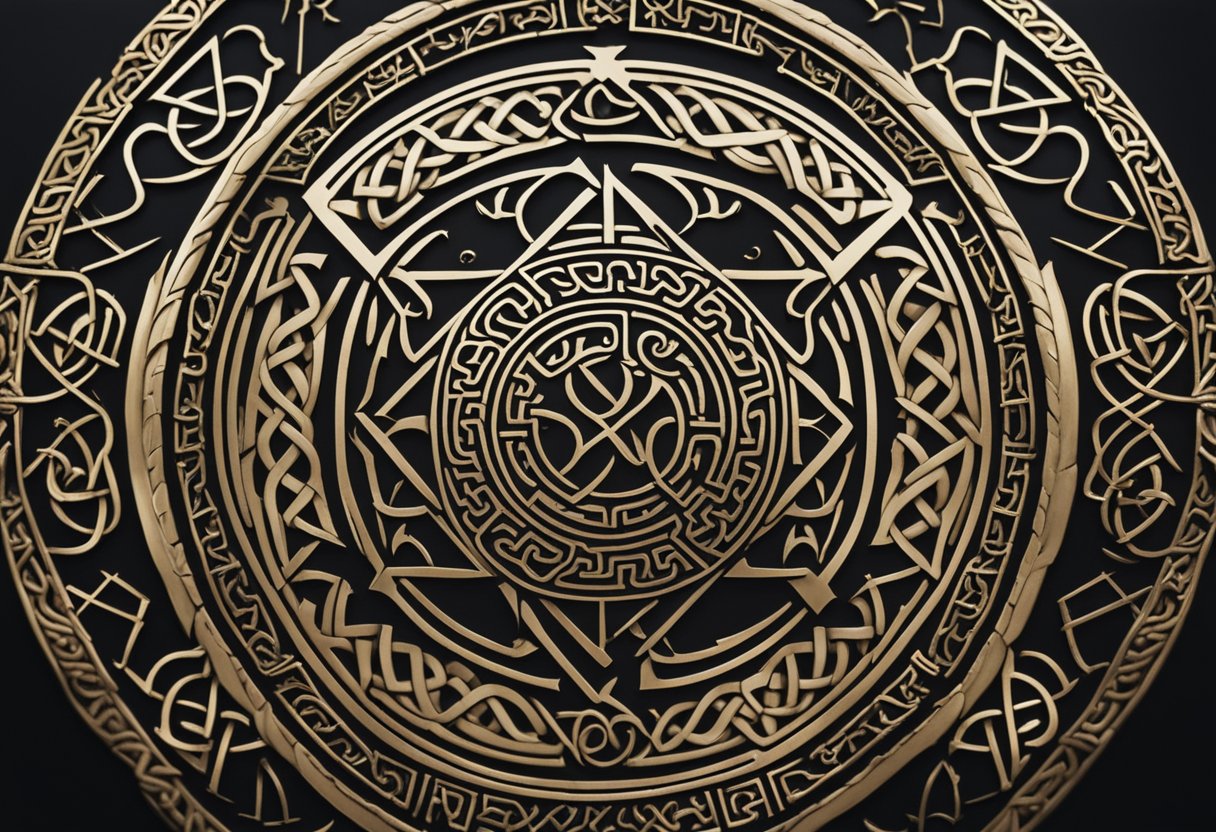
In this section, we explore key aspects of how Norse mythology has influenced Irish folklore, drawing connections between these two rich and storied traditions.
How did Norse mythology influence the development of Irish folklore and myth?
Norse mythology had left its mark on Irish folklore through the Viking Age when Norsemen settled in Ireland and interacted with the Gaelic population. This convergence led to the hybridisation of stories and the introduction of new mythological elements.
What are the similarities between Celtic and Norse mythological traditions?
Both Celtic and Norse myths include a pantheon of gods and heroes, an emphasis on a warrior culture, and a belief in an otherworldly realm. They share themes of fate, magic, and the intertwining of the natural and supernatural worlds.
Can traces of Norse mythology be found in Irish cultural practices?
Yes, evidence of Norse influence can be detected in certain Irish customs. For example, the Yule festival has parallels with the Norse celebration of Jul, and some place names in Ireland have origins in the Norse language.
How did Irish and Norse mythologies interconnect during the Viking Age?
During the Viking Age, as Norse settlers and Gaelic Irish communities interacted, their mythologies began to weave together. This period saw the adoption and adaptation of stories and characters between the two cultures.
What impact did the Norse-Gaelic interactions have on Irish folklore?
Norse-Gaelic interactions during the Viking Age significantly enriched Irish folklore, contributing to a cultural fusion that influenced legends, art, and even language, creating a unique legacy visible in Irish tradition today.
How do the mythological figures in Irish folklore compare to those in Norse mythology?
Irish mythological figures, like the Tuatha Dé Danann, and Norse gods, like the Æsir, both possess supernatural powers and have tales of epic battles and quests. The figures embody values and explore themes salient to their respective cultures.


